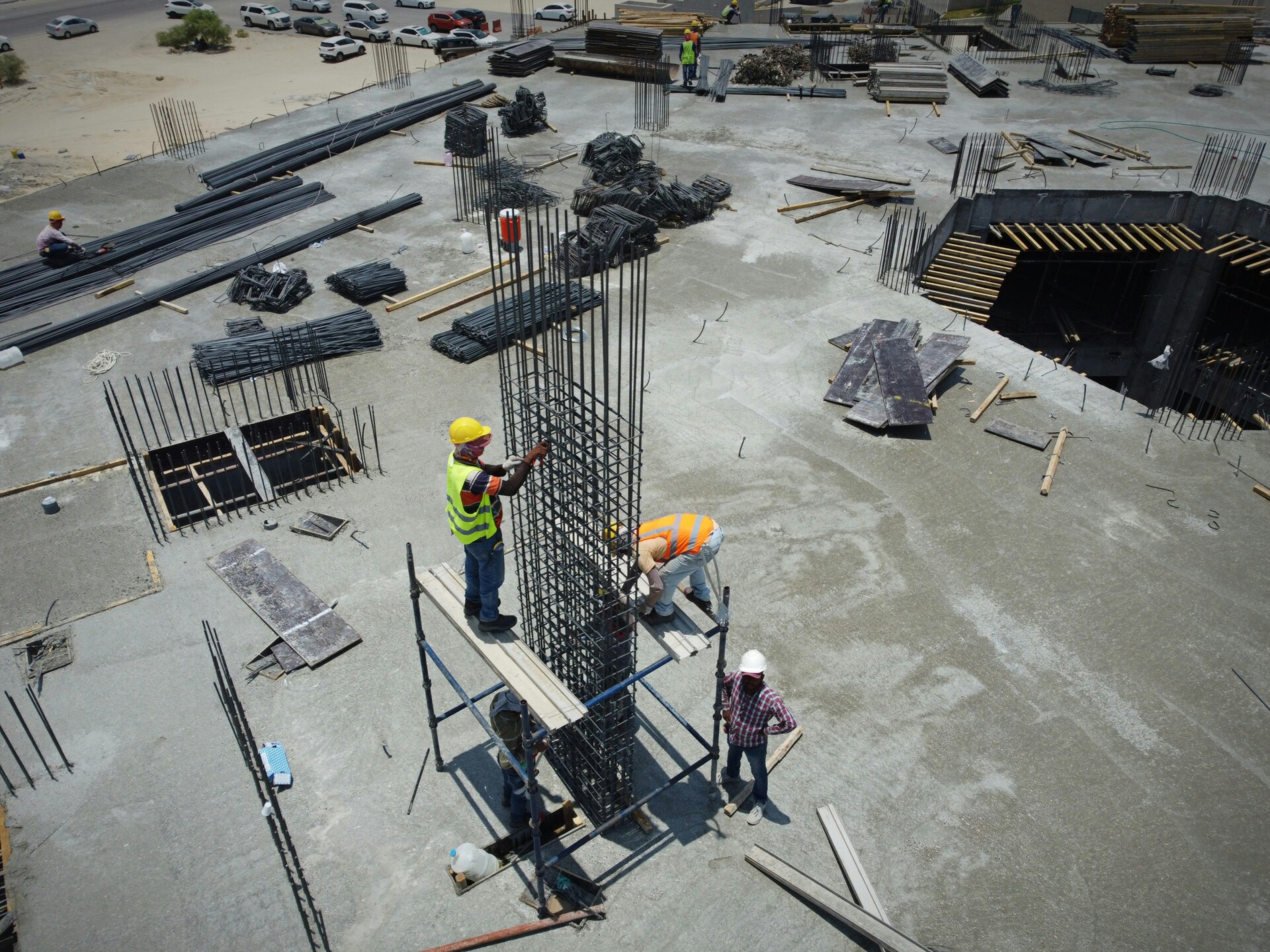A single missed permit deadline can delay an entire project by months. Last year, construction delays cost the U.S. economy over $100 billion, with poor planning cited as the leading cause across residential and commercial sectors.
Construction planning forms the foundation that determines whether we deliver projects on time and within budget or watch them spiral into costly overruns. The process defines how we manage and execute every aspect of a project from initial design through final closeout, establishing clear scope boundaries, realistic timelines, resource requirements, and communication protocols that keep all stakeholders aligned throughout the construction lifecycle.
What Are The Core Elements Of A Solid Construction Plan?

A solid construction plan consists of nine essential elements that guide projects from initiation through closeout. Each component builds on the others to create a comprehensive framework for project execution. We organize these elements into clear categories that address scope definition, work structure, scheduling, resource management, financial control, risk mitigation, compliance, communication, and tracking systems.
Objectives And Scope
Define what success looks like and establish clear work boundaries. Project objectives translate business goals into measurable outcomes, while scope statements outline exactly what will be delivered and what falls outside the project limits. Document these boundaries early to prevent scope creep and align stakeholder expectations throughout the construction process.
Scope definition includes deliverables, exclusions, assumptions, and constraints. We specify quality standards, performance criteria, and acceptance requirements to ensure all parties understand the final product. Clear objectives provide decision-making criteria when changes arise during construction phases.
Work Breakdown Structure
Break the project into manageable packages and tasks with clear ownership. A work breakdown structure organizes complex construction projects into hierarchical components, starting with major deliverables and drilling down to specific activities. Each work package should represent a logical unit of work that can be assigned to a specific team or contractor.
We create WBS elements that align with our project delivery method and organizational structure. Task ownership becomes clear when each work package has a single point of accountability. This structure forms the foundation for scheduling, budgeting, and progress tracking throughout the project lifecycle.
Schedule And Milestones
Map activity order, durations, and key dates to create a realistic project timeline. Scheduling involves sequencing activities based on logical dependencies and resource availability. We establish major milestones that represent significant project achievements and decision points for stakeholders.
Project milestones serve as checkpoints for progress evaluation and risk assessment. These key dates help coordinate subcontractor activities and material deliveries. We build buffer time into critical path activities to accommodate weather delays, permit approvals, and coordination requirements that commonly affect construction schedules.
Resources And Procurement
Identify labor, equipment, materials, and how they will be acquired and staged. Resource planning ensures the right people and materials arrive when needed without creating site congestion or storage issues. We develop procurement strategies that balance cost, quality, and delivery timing to support the overall project schedule.
Procurement planning includes vendor selection, contract negotiations, and delivery coordination. We establish staging areas and logistics plans to minimize material handling costs and site disruptions. Equipment planning considers rental versus purchase decisions based on duration of use and future project needs.
Budget And Cost Control
Build estimates and track costs against the plan throughout the job. Cost control starts with accurate estimates based on current market prices and historical data. We establish cost codes that align with the WBS to enable detailed tracking of actual versus budgeted expenses across all project phases.
Budget monitoring requires regular reporting and variance analysis to identify potential overruns early. We implement change order procedures that require approval before additional work begins. Cost forecasting helps predict final project costs based on current spending trends and remaining work scope.
Risk And Safety
List financial, project, legal, and safety risks and how to mitigate them. Risk mitigation starts with systematic identification of potential threats to project success. We develop specific response strategies for each identified risk, including contingency plans and trigger points for implementation.
Safety protocols are established before work begins and enforced throughout construction. We create site-specific safety plans that address hazards unique to the project location and scope. Regular safety meetings and inspections ensure protocols remain current as project conditions change.
Legal And Compliance
Secure permits and adhere to applicable regulations and standards. Permit acquisition begins during preconstruction and continues as needed throughout the project. We maintain current knowledge of building codes, environmental regulations, and safety requirements that apply to our specific project type and location.
Compliance tracking ensures all regulatory requirements are met before inspections occur. We coordinate with local authorities to understand approval processes and timing requirements. Documentation of compliance activities supports smooth project closeout and occupancy permit issuance.
Communication And Documentation
Establish who needs what information, when, and how. Communication protocols define reporting relationships and information flow between project stakeholders. We create documentation standards that support decision-making and provide audit trails for project activities.
Documentation tracking maintains current records of submittals, approvals, change orders, and progress reports. Regular stakeholder meetings ensure alignment between design intent and construction execution. We use collaborative platforms that provide real-time access to project information for authorized team members.
Coding Systems
Use standard activity and cost codes to improve tracking and reporting across tasks and phases. Activity coding enables consistent progress measurement and resource allocation tracking. We implement cost coding systems that support detailed analysis of labor, material, and equipment expenses by trade or work package.
Standardized coding facilitates comparison between projects and supports continuous improvement initiatives. These systems enable automated reporting that saves administrative time while providing accurate project performance data. Consistent coding practices improve our ability to develop reliable estimates for future similar projects.
How Do You Structure Work And Sequence Activities Effectively?
Structuring construction work starts with breaking down complex projects into clear, manageable activities. We establish logical relationships between these tasks to create a roadmap that prevents conflicts and optimizes resource flow. The right sequencing approach depends on your project type, constraints, and team capabilities.
Define Tasks With Clear Hierarchies
Every design element requires specific activities to bring it to completion. We list all necessary work, from major structural components down to finishing details. This creates a comprehensive activity inventory that covers the full scope.
Building task hierarchies helps organize work from summary level down to detailed operations. Summary tasks might include “Foundation Work” or “Mechanical Systems,” while detailed operations break these into specific activities like “Excavate footings” or “Install ductwork in Zone A.” This structure makes assignments clear and tracking straightforward.
Set Logical Precedences
Precedence relationships define what must happen before other work can start. We specify these connections to prevent scheduling conflicts and ensure work flows in the right order. Foundation work must precede framing, and rough electrical must come before drywall installation.
Logic loops create impossible conditions where activities depend on each other in circular patterns. Missing links leave activities floating without proper connections to the project timeline. Both problems disrupt scheduling calculations and create confusion during execution.
Lags account for necessary waiting periods between related activities. Concrete curing requires time before subsequent work can proceed safely. Weather delays, material delivery windows, and inspection schedules also create natural lags that we build into the sequence.
Choose The Right Planning Technique
Different project types call for different scheduling approaches. The Critical Path Method works best for logic-driven schedules where task dependencies are well-defined. It identifies the longest path through the project and highlights activities that directly impact completion dates.
PERT suits projects where task durations involve uncertainty. This technique uses optimistic, pessimistic, and most likely time estimates to calculate expected durations. It handles variability better than fixed-duration approaches.
Line of Balance excels for repetitive linear work like high-rise buildings or pipeline installation. It visualizes how crews move through repeated sequences across different locations or floors. This technique balances production rates to maintain steady workflow.
Q-scheduling aligns quantities, locations, and time to optimize resource deployment. Resource-oriented scheduling prioritizes when key resources are limited or expensive. Last Planner practices focus on short-term commitment planning to stabilize weekly work and improve schedule reliability.
Leverage Visual Tools For Clarity
Gantt charts transform complex schedules into visual timelines that show task durations, dependencies, and progress at a glance. Team members can quickly understand when their work starts, how it connects to other activities, and whether the project stays on track.
These charts work particularly well for communicating with stakeholders who need schedule overviews without detailed technical information. Updates become visible immediately, and potential conflicts stand out before they cause delays.
Plan Spatial Sequencing
Construction work occupies physical space, creating constraints that traditional scheduling tools might miss. Continuous-space constraints require careful coordination between activities that share the same work areas.
Trench excavation must stay ahead of formwork crews to avoid conflicts. Interior trades need coordinated access to avoid interfering with each other’s work. We plan these spatial relationships to prevent crews from working in each other’s way.
Site logistics become critical when multiple activities compete for the same space or access routes. Staging areas, equipment placement, and material delivery routes all influence how we sequence work.
Use Simulation And 4D Modeling
Simulation allows us to test construction sequences before mobilizing crews and equipment. We can identify access problems, resource clashes, and phasing conflicts in a virtual environment where changes cost nothing.
4D modeling combines 3D building models with schedule information to visualize how construction progresses over time. This reveals spatial conflicts that traditional scheduling methods might miss. It also helps communicate complex sequences to project teams and stakeholders.
These tools let us experiment with different approaches and optimize sequences before committing resources. We can test what-if scenarios and validate that our planned approach will work in practice.
How Do You Estimate Durations, Resources, And The Budget With Confidence?

Accurate estimation forms the backbone of every successful construction project. We base our approach on measurable drivers rather than guesswork, using historical data and proven methodologies to develop realistic projections. The key lies in understanding how quantities, crew capabilities, and site conditions interact to determine actual project costs and timelines.
Duration Estimating Based On Quantities And Productivity
Duration estimates start with quantity takeoffs paired with crew productivity rates. We calculate work hours by dividing total quantities by crew output per hour, then factor in site-specific conditions that affect performance. A concrete crew might pour 50 cubic yards per day under ideal conditions, but access restrictions or complex reinforcement can reduce that rate significantly.
Learning curves affect productivity as crews become familiar with repetitive tasks. The first few iterations of a process typically take longer as teams establish rhythm and identify efficient workflows. We account for this by front-loading time estimates early in the schedule and adjusting productivity assumptions as work progresses.
Weather impacts vary by season, location, and activity type. Exterior concrete work faces different constraints than interior finishing, requiring weather-specific buffers in our schedules. We review historical weather data for the project location and build appropriate delays into critical path activities that cannot proceed during adverse conditions.
Resource Planning For Crews And Equipment
Standard crew compositions provide the foundation for resource planning. We define typical crew sizes, skill mixes, and equipment requirements for each activity type based on proven combinations that maximize efficiency. A standard masonry crew might include two masons, one tender, and specific scaffolding requirements that we apply consistently across similar work packages.
Space constraints limit how many crews can work simultaneously in a given area. We evaluate workspace requirements for each activity and identify potential conflicts before scheduling overlapping work. More resources do not automatically translate to faster completion if crews interfere with each other or compete for limited staging areas.
Equipment coordination requires careful timing to match delivery, use, and removal with actual construction needs. We plan equipment mobilization based on activity start dates and ensure adequate time for setup and calibration. Specialized equipment like tower cranes or concrete pumps must align with multiple activities across the schedule.
Technology Choices Impact Cost And Schedule
Method selection significantly affects both duration and cost estimates. Pumping concrete versus using buckets changes labor requirements, equipment needs, and completion times. We evaluate alternatives during preconstruction and select methods that balance speed, cost, and quality requirements for each specific situation.
Automated systems like laser-guided equipment can reduce labor hours while improving accuracy. However, these technologies require different crew compositions and may involve higher equipment costs. We analyze the trade-offs between traditional methods and newer technologies based on project scale, timeline, and budget constraints.
Simulation allows us to test different approaches before committing resources. We model various scenarios to understand how method choices affect overall project flow and identify the most efficient combination of techniques for each phase of work.
Budgeting Steps And Stakeholder Review
Our budgeting process begins with comprehensive research into project requirements and site conditions. We analyze design documents, conduct site visits, and gather input from specialized trades to build accurate cost projections. This groundwork prevents surprises that can derail budgets during construction.
Scope confirmation with design teams ensures our estimates align with project intent. We review specifications, clarify ambiguities, and identify potential value engineering opportunities before finalizing numbers. Early coordination prevents costly changes once construction begins.
Stakeholder reviews provide essential feedback and buy-in for our cost projections. We present estimates with clear assumptions and contingency allowances, explaining how we derived our numbers and what risks we have accounted for. This transparency builds confidence and establishes realistic expectations for project delivery.
Probabilistic Scheduling For Uncertainty Management
When task durations carry significant uncertainty, we use three-point estimation techniques to capture the range of possible outcomes. Best-case, likely, and worst-case scenarios help us understand the full spectrum of potential durations and build appropriate buffers into critical activities.
Probabilistic scheduling acknowledges that construction work involves inherent variability. Rather than using single-point estimates that may prove unrealistic, we model duration ranges and use statistical methods to determine confidence levels for our overall schedule. This approach provides more realistic completion dates and helps identify activities that pose the greatest schedule risk.
Contingency planning becomes more targeted when we understand which activities carry the most uncertainty. We focus risk mitigation efforts on high-variability tasks and maintain flexibility in our schedules to accommodate the inevitable variations that occur during construction.
How Should You Monitor, Control, And Close Out The Project?
Project controls operate on a simple cadence: measure performance, meet with teams, and adjust course. We track key performance indicators to understand where the project stands against the baseline plan. Schedule adherence shows whether milestones align with contract dates. Budget performance reveals cost variance against approved estimates. Quality benchmarks confirm that deliverables meet specified standards and acceptance criteria.
Documentation tracking forms the backbone of project controls. We maintain current logs for daily activities, equipment usage, and material deliveries. Submittals require organized tracking from initial submission through approval cycles. Test reports document quality verification and compliance with specifications. These records support real-time decisions and provide audit trails for stakeholder reporting and future reference.
Coordination Cadence And Team Communication
Regular check-ins with team leads create accountability and early problem identification. We compare actual progress against planned schedules during weekly coordination meetings. Budget reviews occur monthly to catch cost deviations before they compound. Quality assessments happen at predetermined inspection points to verify work meets standards before subsequent activities begin.
Course correction happens early when variance analysis reveals problems. Schedule delays trigger resource reallocation discussions. Budget overruns require scope adjustments or value engineering reviews. Quality issues demand immediate remediation plans. The key lies in catching problems while solutions remain manageable rather than waiting until they become major obstacles.
Safety Management And Regulatory Compliance
Safety protocols require consistent enforcement throughout construction phases. Training records document that workers understand hazard recognition and proper procedures. Personal protective equipment inspections ensure compliance with safety standards. Signage installation maintains clear communication of hazards and requirements across work zones.
Controlled site visits manage access for inspectors, stakeholders, and visitors. We verify current permits before each construction phase and track regulatory requirement changes. Compliance documentation supports inspections and demonstrates adherence to applicable codes and standards. Regular safety audits identify potential issues before they result in incidents or violations.
Risk Review Processes
Risk conditions change as projects progress through different phases. Financial risks shift when material costs fluctuate or payment schedules adjust. Project risks evolve when design modifications affect scope or sequence. Legal risks emerge when permit conditions change or neighbor relations require attention. Safety risks vary with weather conditions, work phases, and crew compositions.
We revisit risk registers monthly to reassess probability and impact ratings. New risks require mitigation strategies and responsibility assignments. Closed risks free up contingency reserves for active issues. Risk communication keeps stakeholders informed about current exposures and response plans.
Project Closeout And Documentation Handover
Closeout activities begin during the final construction phases rather than after work completion. We compare final costs against the original budget to document project performance and capture cost lessons. Punch list completion requires systematic inspection and remediation of deficient work items. Quality assurance documentation compilation ensures all required testing and verification records transfer to the owner.
Turnover documentation packages include as-built drawings, operation manuals, warranty information, and maintenance schedules. Training requirements for owner personnel receive scheduling and completion verification. Equipment commissioning reports demonstrate system functionality and performance validation. Financial reconciliation confirms all costs are properly allocated and invoiced according to contract terms.
Lessons-learned sessions capture insights from all project phases and team perspectives. We document what worked well and what requires improvement for future projects. These insights feed directly into our next preconstruction planning process, creating continuous improvement across our project portfolio. According to project management best practices, thorough documentation during closeout provides valuable historical data for estimating and planning similar future work.
Conclusion and Next Steps

A clear construction planning process links scope, tasks, resources, time, cost, risk, and safety into one master plan. Define the work, sequence it well, estimate with realistic drivers, and monitor with simple KPIs. Close strong with documentation and lessons learned.
For your next project, start with a detailed initiation package, build a WBS and logic-driven schedule, and set up tracking before mobilization. This preconstruction investment drives continuous improvement across all future builds.
Ready to strengthen your construction planning process? Connect with EB3 Construction to discuss how we can support your next development project.




